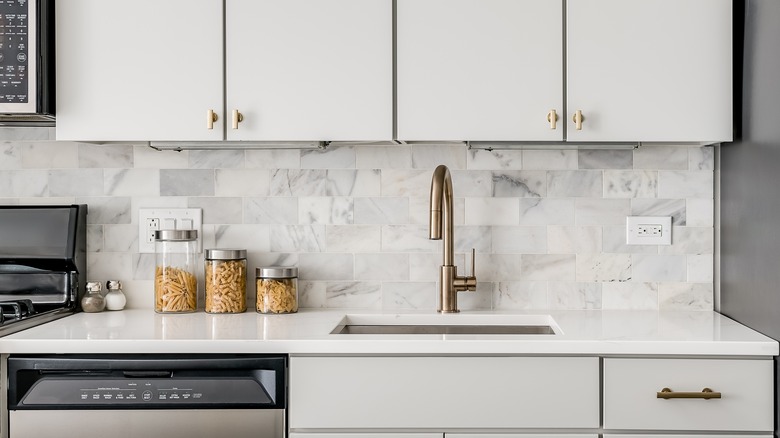The TikTok-Approved Product That Makes Tiling Projects Easier Than Ever
Tile transforms any room you install it in. It can make a dated kitchen feel elegant when the backsplash is updated, a boring powder room feel elevated with a tile accent wall, or an empty nook feel intentional with the help of a splashy design. However, some people avoid experimenting with tiles because of how time-consuming the project can be. Dealing with mortar isn't easy, and it has the potential to become a messy project if you're inexperienced. That's because it is made from a mixture of cement, sand, lime, and water, and it's easy to use too little or too much of the mixture, creating issues down the line. However, there is one TikTok-approved product that can make the entire experience so much easier, and that is MusselBound.
MusselBound is a sticky membrane you add to the wall, and it replaces the need to use mortar. Because of this, even a newbie to home repair can feel comfortable and confident with arranging and securing tiles to a wall. Here is everything you need to know about this product. Let's see if it's a fit for your next home improvement project!
How to use MusselBound during your next project
MusselBound replaces mortar in your tiling project, which means you can skip some of the mess. To use the membrane, first clean the surface you want to tile. Make sure the wall has no dust or residual debris on it so the sticky adhesive can go on smoothly without any bumps or obstacles. It's recommended to cut off a 1-inch sliver from the roll to test drive the adhesive to become comfortable with how it works. It has two sticky sides — one on the back that attaches to the wall, and one on the front that attaches to the tiles. First, experiment with the backing. Take a second to apply it to a surface with gentle pressure, which allows you to still unstick and adjust it. But then notice that if you apply firm pressure, the MusselBound will stick much more solidly, making it trickier to reposition. Do the same with the top surface, experimenting with how tiles stick to the glue. Once you feel comfortable with the mechanics, it's time to apply it to your wall.
To apply it, remove the protective backing and slowly stick it to your wall from the top down. Roll it down to either the counter or floor, and then use a ruler and utility knife to create a straight, crisp cut to remove it from the roll. Press it firmly against the wall to make it adhere. Once it is in place, remove the protective sheet on the front, revealing the second adhesive side. Apply your tiles directly onto the glue, pressing each one in firmly. Once arranged, use grout to seal the tiles and finish your project.
Caveats to keep in mind
MusselBound is great because it has a long list of uses. You can use it tile directly over other tiles, wood panels, or Formica, negating the need for a messy demo. You can also use it on everything from kitchen backsplashes to shower walls to fireplace surrounds. However, this is not recommended to be used on floors and ceilings, because they usually aren't perfectly level, which can create cracked tiles down the line. You also shouldn't use it on pool or shower floors or on outside projects. That's because the product isn't designed to be fully submerged underwater. You can still use it in areas like shower or bathroom walls since they won't be fully submerged — but you will need to add an extra product to make it water-resistant, which is the MusselBound Waterproofing System Seam Tape. Apply it to the seams where the different sheets of MusselBound mats meet. This ensures that water doesn't get behind the mats and to the wall underneath, which would cause mold and mildew.
Secondly, MusselBound creates a permanent seal, so do not use it for temporary projects in apartments. Trying to remove the tile afterward will most likely damage the wall behind it. Lastly, always grout your tiles after finishing the project in order to seal and stabilize them. The grout acts as a final layer to keep the design in place. When using mortar, you typically need to wait a day for it to set. But since you're just using a sticky membrane, you can grout the tiles as soon as you set them.
